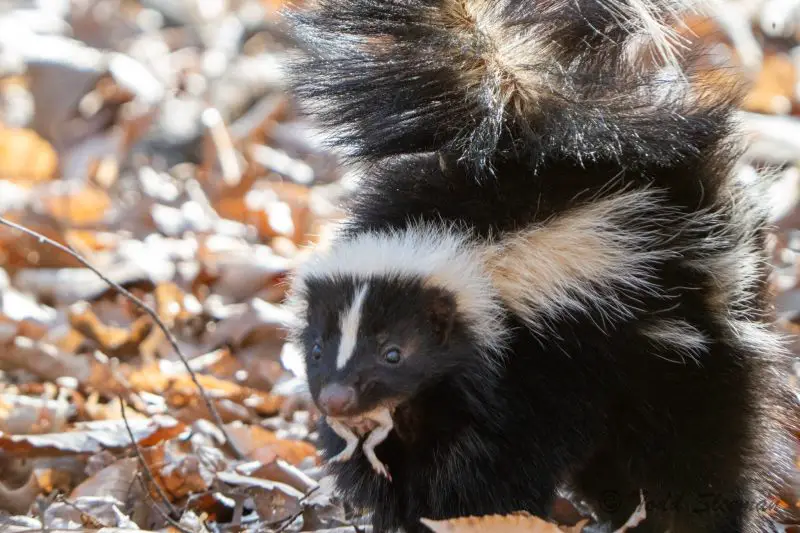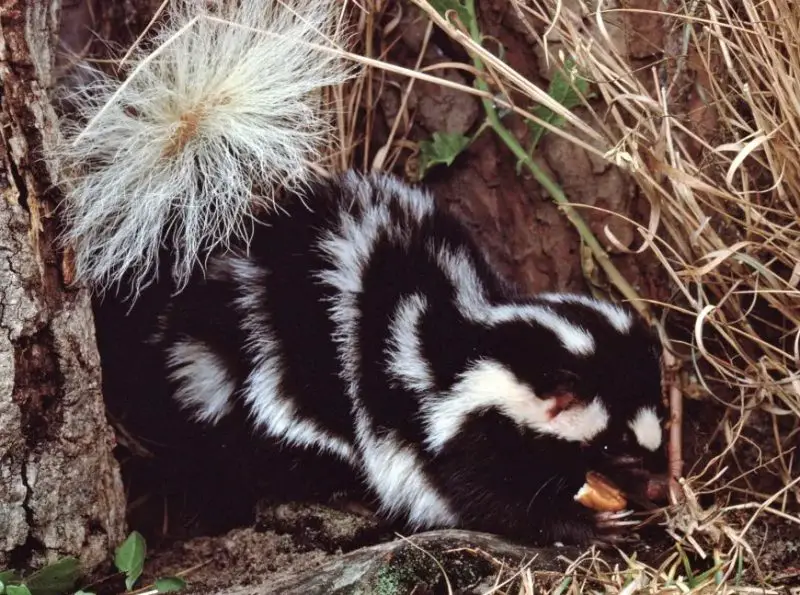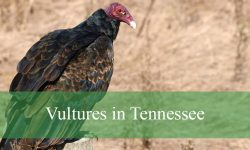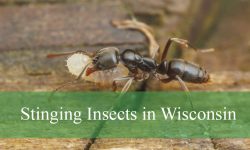Skunks are iconic mammals in North America, easily recognized for their striking black-and-white fur and notorious defense mechanism of spraying a pungent odor when threatened. In Ohio, two skunk species are commonly found: the Striped Skunk (Mephitis mephitis) and the Eastern Spotted Skunk (Spilogale putorius). Although they share the same family, Mephitidae, they differ in appearance, behavior, diet, and habitat. Learning to distinguish between them is important for wildlife enthusiasts, gardeners, and homeowners who may encounter these nocturnal mammals.
Both species play a crucial ecological role by controlling insect and rodent populations. This guide will provide a comprehensive look at the two Ohio skunk species, covering physical characteristics, behavior, diet, reproduction, habitat, and fascinating facts.
Striped Skunk (Mephitis mephitis)

Identification and Physical Characteristics
The striped skunk is the most familiar and widespread skunk in Ohio. Its fur is primarily black with two bold white stripes running from the head along the back. These stripes sometimes merge into a single stripe along the tail. Adults typically measure 20 to 31 inches in length, including their bushy tail, and weigh between 4 and 10 pounds. Their fur is thick and soft, providing insulation during Ohio’s cold winters. Striped skunks have small, rounded ears and a pointed snout, which enhances their sense of smell—vital for locating food.
Distinctive markings make the striped skunk easy to identify. Unlike the spotted skunk, its white stripes are continuous and symmetrical. Juvenile striped skunks resemble adults but have softer fur and may display less pronounced stripe patterns.
Behavior and Activity Patterns
Striped skunks are primarily nocturnal, emerging at night to forage. They are generally solitary except during mating season or when a mother is raising her young. Despite their defensive spray, they are not naturally aggressive and often freeze or stomp their feet as a warning before releasing their scent. Their excellent sense of smell helps them locate insects, small rodents, and even carrion.
These skunks are also known for their adaptability. They can thrive in forests, fields, suburban neighborhoods, and urban areas. They are proficient diggers, creating dens in burrows, hollow logs, or under human structures like sheds and porches.
Diet and Feeding Habits
Striped skunks are omnivorous opportunists. In Ohio, their diet includes insects such as beetles, grasshoppers, and crickets, small mammals like mice, fruits, berries, and occasionally eggs. They are particularly useful for controlling garden pests, including grubs and insect larvae. Foraging often occurs at night, and they use their sharp claws to dig for insects and roots. They occasionally scavenge human food or pet food left outside.
Reproduction and Life Cycle
Mating season for striped skunks in Ohio occurs from late February through March. Males actively search for females, sometimes traveling long distances. After a gestation period of approximately 60 to 77 days, females give birth to litters of 4 to 7 kits in underground dens. The kits are born blind and helpless, relying entirely on the mother for warmth and food. They begin to explore outside the den after about six weeks and are fully independent by two to three months. Adult striped skunks have a lifespan of 3 to 4 years in the wild, though some can live up to 7 years.
Habitat and Distribution in Ohio
Striped skunks are widely distributed across Ohio, from forested areas to suburban neighborhoods. They prefer areas with dense cover and access to water but are highly adaptable and can thrive in farmlands, parks, and even urban gardens. Their burrows are often hidden under logs, rock piles, or human structures. Seasonal movement is minimal, although they may shift dens in response to food availability or harsh weather.
Fun Facts About Striped Skunks
Striped skunks can spray their defensive odor up to 10 feet with remarkable accuracy. Interestingly, they usually give warning signals, such as stamping their feet or hissing, before spraying. Their coloration serves as an effective warning to predators, a phenomenon known as aposematism. Despite their fearsome reputation, they rarely spray humans unless provoked or cornered.
Eastern Spotted Skunk (Spilogale putorius)

Identification and Physical Characteristics
The eastern spotted skunk is smaller and more elusive than the striped skunk. Adults typically measure 14 to 22 inches in length and weigh 1 to 3 pounds. Its fur is black with broken white stripes, spots, or “broken patterns” along the back, creating a unique, checkerboard-like appearance. The slender body and short legs give it a more delicate appearance compared to the robust striped skunk.
This skunk is agile and capable of climbing low trees or shrubs. Its tail is long and bushy, often used for balance. The eastern spotted skunk has a pointed face with small rounded ears and keen eyesight adapted to nocturnal activity.
Behavior and Activity Patterns
Eastern spotted skunks are highly nocturnal and more secretive than striped skunks. They exhibit a distinctive handstand-like threat display, lifting their hind legs in the air to warn potential predators before spraying. They are excellent climbers and use this skill to escape danger or reach bird eggs and insects in shrubs and low trees. They are generally solitary, except during the breeding season or when a female is raising her kits.
Unlike the more common striped skunk, eastern spotted skunks tend to have smaller home ranges and are less frequently seen near human habitation, preferring remote woodlands, brushy fields, and farmlands with abundant cover.
Diet and Feeding Habits
Eastern spotted skunks are omnivorous and opportunistic. Their diet includes insects, small rodents, eggs, fruits, and seeds. They are particularly effective at controlling insect populations, consuming large numbers of beetles, grasshoppers, and other pests. Their small size allows them to forage in tight spaces, and they often hunt by flipping leaves and digging shallow holes in search of insects or grubs.
Reproduction and Life Cycle
Mating occurs in late February to March, similar to striped skunks. Females typically give birth to 4 to 7 kits after a gestation of about 66 days. The kits are born blind and dependent on their mother, opening their eyes around two weeks of age. They begin exploring outside the den at six to eight weeks and are fully independent after approximately two months. Eastern spotted skunks live 3 to 4 years in the wild, although predation and environmental pressures may reduce their lifespan.
Habitat and Distribution in Ohio
Eastern spotted skunks are less common than striped skunks and are concentrated in rural woodlands, brushy fields, and areas with dense cover. They prefer environments with natural hiding spots, such as rock piles, hollow logs, and abandoned burrows. While sightings in Ohio are rare compared to striped skunks, they play an important ecological role in controlling insect and rodent populations.
Fun Facts About Eastern Spotted Skunks
The eastern spotted skunk’s unique handstand display is not only an intimidation tactic but also positions its scent glands for maximum reach if spraying becomes necessary. Their climbing ability sets them apart from other skunks, allowing them to access bird eggs and insects unreachable by other species. Despite being smaller, they are effective hunters and play a significant role in controlling local pest populations.
Comparing Striped and Eastern Spotted Skunks in Ohio
Both skunk species share the ability to spray a pungent defensive odor and are primarily nocturnal, yet their size, markings, and behaviors make them easy to distinguish. Striped skunks are larger and more common, with continuous bold stripes, whereas eastern spotted skunks are smaller, rarer, and marked with broken stripes and spots. The striped skunk is highly adaptable to human-altered landscapes, while the spotted skunk prefers more secluded, natural habitats.
Diet overlaps between the two species, but the spotted skunk is more agile and able to climb vegetation to access food sources. Reproductive patterns are similar, though the spotted skunk may be slightly more secretive during the breeding season. Both species contribute significantly to controlling insect and rodent populations in Ohio.
Safety and Observation Tips
Observing skunks in Ohio requires caution and respect for their space. Both species are generally non-aggressive but will spray if threatened. It is best to maintain a safe distance, use binoculars or cameras for observation, and avoid cornering or startling the animals. Nighttime walks with a flashlight or wildlife cameras are effective methods to view these elusive mammals.
To reduce unwanted encounters near homes, it is advisable to secure garbage, avoid leaving pet food outside, and block access to potential den sites under sheds or decks.
Best Time and Places to Observe Skunks in Ohio
Observing skunks in the wild can be a fascinating experience, but it requires careful timing and knowledge of their preferred habitats. Skunks are nocturnal mammals, so the best time to see them is during dusk and early night hours, typically between 8:00 PM and midnight. During these hours, they emerge from their dens to forage for food, including insects, small rodents, fruits, and berries. Spring and early summer are especially active periods, as this coincides with the breeding season and the time when mothers are raising their kits.
Skunks can be observed in a variety of habitats across Ohio, though the specific species may influence where you are most likely to see them. Striped skunks are highly adaptable and can be spotted near suburban neighborhoods, farms, parks, and forest edges, often near garbage bins or gardens where food is accessible. Their dens may be located under sheds, decks, hollow logs, or rock piles. In contrast, eastern spotted skunks are more elusive and prefer remote woodlands, brushy fields, and areas with dense ground cover, making sightings less common but rewarding for wildlife enthusiasts.
For safe and effective observation, it is recommended to use flashlights, binoculars, or wildlife cameras from a distance to avoid startling the skunks. Avoid approaching their dens directly, as both species may spray when threatened. Observing quietly from a safe location at night provides the best chance to witness their natural foraging behaviors, social interactions, and unique defensive displays.
By visiting these areas during the right time of day and season, wildlife lovers in Ohio can experience firsthand the fascinating nocturnal lives of these iconic mammals while respecting their natural behaviors.
Conclusion
Ohio’s two skunk species—the striped skunk and eastern spotted skunk—offer fascinating insights into the state’s wildlife. Recognizing their distinct markings, behaviors, and habitats allows for safe observation and appreciation of their ecological contributions. From their nocturnal foraging habits to their unique defense mechanisms, skunks remain intriguing and important members of Ohio’s mammal population.
Both species serve as natural pest controllers and indicators of healthy ecosystems. By understanding and respecting these creatures, Ohio residents can coexist safely with one of the region’s most iconic mammals.
FAQs About Skunks in Ohio
What types of skunks live in Ohio?
Ohio is home to two primary skunk species: the Striped Skunk (Mephitis mephitis) and the Eastern Spotted Skunk (Spilogale putorius). Striped skunks are larger, more common, and easily recognized by their continuous white stripes, while eastern spotted skunks are smaller, rarer, and have broken stripes and spots along their back.
When are skunks most active in Ohio?
Skunks are nocturnal, so they are most active during dusk and nighttime, especially between 8:00 PM and midnight. Spring and early summer are peak activity times due to breeding and when mothers are raising their young.
Where can I safely observe skunks in Ohio?
Striped skunks can be spotted in suburban neighborhoods, farms, parks, and forest edges, often near food sources or dens under decks, sheds, or logs. Eastern spotted skunks prefer remote woodlands and brushy fields with dense cover. Observing from a distance using flashlights, binoculars, or wildlife cameras is recommended to avoid disturbing them.
What do skunks eat in Ohio?
Both skunk species are omnivorous. Their diet includes insects, small rodents, fruits, berries, eggs, and occasionally human food or pet food left outdoors. They are particularly effective at controlling garden pests and insect populations.
How do skunks defend themselves?
Skunks are famous for their ability to spray a strong, foul-smelling odor when threatened. They usually give warnings first, such as stamping their feet, hissing, or performing a handstand display (in the case of eastern spotted skunks) before spraying. This defense mechanism deters predators and allows skunks to escape danger.
Are skunks dangerous to humans or pets?
Skunks are generally non-aggressive and rarely attack humans or pets. However, their spray can be unpleasant, and skunks can carry rabies. It’s important to avoid approaching or cornering them and to supervise pets when outdoors, especially at night.
How can I attract skunks for observation?
While it is not recommended to feed skunks directly, you can attract them safely by maintaining natural habitats, such as leaving brush piles or natural cover in your yard. Nighttime observation from a distance using wildlife cameras or quiet walking trails increases the chances of seeing these nocturnal mammals without disturbing them.






